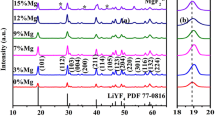Abstract
In this work, a high-performance up-conversion submicron materials for Yb3+–Tm3+–Er3+ triple-doped lutetium vanadate (LuVO4) obtained via simple solid-state method. X-ray diffractometer results showed that the prepared LuVO4: Yb3+/Tm3+/Er3+ samples kept the crystal phase structure of the host LuVO4. Under 980 nm excitation, LuVO4:Yb3+/Tm3+ phosphors exhibited strong blue light emission. After doping of Er3+ ion the color of LuVO4: Yb3+/Tm3+/Er3+ phosphors were gradually changed from the blue to the green region in the CIE map. Next, the luminous color was evaluated by the correlated color temperature. The temperature-sensing characteristics of material were studied by fluorescence intensity ratio (FIR) technology which based on thermal coupling levels (TCLs) and non-TCLs, respectively. It was found that the maximum value of Sa2 is 0.03555 K−1@370 K based on the non-TCLs of 1G4 (Tm3+) and 2H11/2 (Er3+), which is higher than the sensitivity of Sa1 0.01004 K−1@370 K obtained through the TCLs of 4S3/2 (Er3+) and 2H11/2 (Er3+). For Yb3+/Tm3+/Er3+ co-doped LuVO4 up-conversion phosphors, the results demonstrate its great potential for fluorescence display and temperature probing.






Similar content being viewed by others
Data availability
The datasets used or analyzed during the current study are available from the corresponding author on reasonable request.
Code availability
No code usage involved in this paper.
References
H. Zhang, S. Zhao, X. Wang, X. Ren, J. Ye, L. Huang, S. Xu, Journal of Materials Chemistry C. (2019). https://doi.org/10.1039/C9TC04965G
Y. Liu, L. Meng, H. Wang, J. Jiao, M. Xing, Y. Peng, X. Luo, Y. Tian, Dalton Trans. (2021). https://doi.org/10.1039/D0DT03377D
N.O. Nuñez, F. Cussó, E. Cantelar, B. Martin-Gracia, J.M. Fuente, A. Corral, M. Balcerzyk, M. Ocaña, Nanomaterials (2020). https://doi.org/10.3390/nano10010149
A. Krasnikov, V. Tsiumra, L. Vasylechko, S. Zazubovich, Ya. Zhydachevskyy, J. Lumin. (2019). https://doi.org/10.1016/j.jlumin.2019.04.019
D. Duan, Y. Wang, S. Jiang, L. Li, G. Xiang, X. Tang, Y. Li, X. Zhou, J. Lumin. (2019). https://doi.org/10.1016/j.jlumin.2019.116636
Nuria O Nuñez, Fernando Cussó, Eugenio Cantelar, Beatriz Martin-Gracia, Jesús M de la Fuente, Ariadna Corral, Marcin Balcerzyk, Manuel Ocaña, Nanomaterials. (2020). https://doi.org/10.3390/nano10010149
Y. Ma, G. Xiang, J. Zhang, Z. Liu, P. Zhou, W. Liu, X. Tang, S. Jiang, X. Zhou, L. Li, Y. Luo, Y. Jin, J. Alloy. Compd. (2018). https://doi.org/10.1016/j.jallcom.2018.07.368
H. Suo, X. Zhao, Z. Zhang, Y. Wu, C. Guo, ACS Appl. Mater. Interfaces. (2018). https://doi.org/10.1021/acsami.8b18184
P. Peng, N. Wu, L. Ye, F. Jiang, W. Feng, F. Li, Y. Liu, M. Hong, ACS Nano (2020). https://doi.org/10.1021/acsnano.0c02601
H. Wang, Z. Wang, Y. Tu, Y. Li, T. Xu, M. Yang, P. Wang, Y. Gu, Biomaterials (2020). https://doi.org/10.1016/j.biomaterials.2020.119765
R.V. Perrella, P.C.S. Filho, Dalton Trans. (2020). https://doi.org/10.1039/c9dt04308j
Y. Liu, Y. Lu, X. Yang, X. Zheng, S. Wen, F. Wang, X. Vidal, J. Zhao, D. Liu, Z. Zhou, C. Ma, J. Zhou, J.A. Piper, P. Xi, D. Jin, Nature (2017). https://doi.org/10.1038/nature21366
Q. Qiang, Y. Wang, New J. Chem. (2019). https://doi.org/10.1039/C8NJ05079A
W. Ge, M. Xu, J. Shi, J. Zhu, Y. Li, Chem. Eng. J. (2019). https://doi.org/10.1016/j.cej.2019.123546
Y. Zhao, X. Wang, Y. Zhang, Y. Li, X. Yao, J. Alloy. Compd. (2020). https://doi.org/10.1016/j.jallcom.2020.154998
H. Yu, J. Liu, H. Zhang, A.A. Kaminskii, Z. Wang, J. Wang, Laser Photonics Reviews. (2014). https://doi.org/10.1002/lpor.201400022
J. Liao, L. Kong, M. Wang, Y. Sun, G. Gong, Opt. Mater. (2019). https://doi.org/10.1016/j.optmat.2019.109452
D. Li, C. Liu, L. Jiang, Opt. Mater. (2015). https://doi.org/10.1016/j.optmat.2015.04.048
X. Liu, R. Lei, F. Huang, D. Deng, H. Wang, S. Zhao, S. Xu, J. Lumin. (2019). https://doi.org/10.1016/j.jlumin.2019.01.065
G. Zhang, Iva Milisavljevic, Eugeniusz Zych, Y. Wu, Scripta Materialia. 186 (2020). https://doi.org/10.1016/j.scriptamat.2020.04.011
Y. Li, B. Chen, X. Zhao, Zhi. Wang, H. Lin, Journal of Alloys and Compounds. (2012). https://doi.org/10.1016/j.jallcom.2012.05.009
C.D.S. Brites, P.P. Lima, N.J.O. Silva, A. Millán, V.S. Amaral, F. Palacio, L.D. Carlos, Nanoscale (2012). https://doi.org/10.1039/C2NR30663H
G. Xiang, X. Liu, J. Zhang, Z. Liu, W. Liu, Y. Ma, S. Jiang, X. Tang, X. Zhou, L. Li, Y. Jin, Inorg. Chem. (2019). https://doi.org/10.1021/acs.inorgchem.9b01229
P. V. dos Santos, M. T. de Araujo, A. S. Gouveia-Neto, J. A. Medeiros Neto, A. S. B. Sombra, Applied Physics Letters. (1998). https://doi.org/10.1063/1.121861
Z. Wang, H. Jiao, J. Yang, Z. Fu, J. Lumin. (2019). https://doi.org/10.1016/j.jlumin.2018.10.034
Q. Han, H. Hao, J. Yang, Z. Sun, J. Sun, Y. Song, Y. Wang, X. Zhang, J. Alloy. Compd. (2019). https://doi.org/10.1016/j.jallcom.2019.02.047
S. Sinha, M.K. Mahata, K. Kumar, New J. Chem. (2019). https://doi.org/10.1039/C9NJ00760A
G. Chen, R. Lei, H. Wang, F. Huang, S. Zhao, S. X, Optical Materials. (2018). https://doi.org/10.1016/j.optmat.2018.01.039
Z. Liu, D. Chen, J. Mater. Sci.: Mater. Electron. (2020). https://doi.org/10.1007/s10854-020-03471-y
J. Wu, X. Chen, F. Jiang, X. Feng, Q. Huang, Q. Lin, Physica B (2019). https://doi.org/10.1016/j.physb.2019.02.051
Acknowledgements
This work is supported by the Developing Project of Science and Technology of Jilin Province (Grant No. 202002040JC).
Funding
This research did not receive any specific grant from funding agencies in the public, commercial, or not-for-profit sectors.
Author information
Authors and Affiliations
Contributions
LC developed the idea for the study, LC, ZW and PC did the analyses, and XH, BZ and XC wrote the paper. The statements are not mandatory.
Corresponding author
Ethics declarations
Conflict of interest
The authors declare that they have no known competing financial interests or personal relationships that could have appeared to influence the work reported in this paper.
Ethical approval
We the undersigned declare that this manuscript is original, has not been published before and is not currently being considered for publication elsewhere.
Consent for participate
All authors have read this manuscript and would like to participate in the journal submission.
Consent for publication
All authors have read this manuscript and would like to have it considered exclusively for publication in Materials in Electronics.
Additional information
Publisher's Note
Springer Nature remains neutral with regard to jurisdictional claims in published maps and institutional affiliations.
Rights and permissions
About this article
Cite this article
Cao, L., Wang, Z., Cai, P. et al. Up-conversion luminescence properties of LuVO4: Yb3+/Tm3+/Er3+ submicron materials for high sensitivity temperature probing. J Mater Sci: Mater Electron 32, 28088–28097 (2021). https://doi.org/10.1007/s10854-021-07183-9
Received:
Accepted:
Published:
Issue Date:
DOI: https://doi.org/10.1007/s10854-021-07183-9




